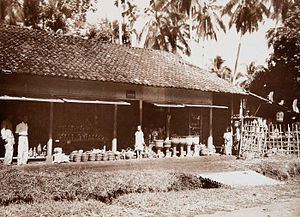Province West Java | ||
 | ||
Plered (also Pleret) was the location of the palace of Amangkurat I of Mataram (r. 1645–1677). The remains are now located in the Bantul Regency, Special Region of Yogyakarta, Indonesia, close to the banks of the Opak River, and south of Kota Gede.
Contents
- Map of Plered Purwakarta Regency West Java Indonesia
- Construction
- Fall of Plered during Trunajaya rebellion
- During Diponegoro War
- Decline
- Today
- References
Map of Plered, Purwakarta Regency, West Java, Indonesia
It has been researched for archaeological remains It is located to the east of the site of Sultan Agung's Karta Palace at Karta. It is also the location of extensive irrigation and other water works which occurred at the time of the palace being used.
Construction
Sultan Agung (r. 1613–1645) built the previous court complex at Karta and moved the capital there in the first decade of his reign. The decision to move to a new capital might have been made during his reign in 1634, when a fire in Karta killed "many people of the court". In 1644, Sultan Agung started building an artificial lake in an area which became known as Plered. He died two years later and was succeeded by his son Amangkurat I. In 1647, shortly after taking the throne, Amagkurat built his royal residence near the lake and moved the court there. In contrast to Karta, which was made of wood, the royal compound at Plered was built of brick. Amangkurat continued to expand this complex up to 1666.
Fall of Plered during Trunajaya rebellion
In 1677, during the Trunajaya rebellion, Plered was taken by the rebel forces, consisting of Madurese troops, as well as Javanese forces from East Java and central northern coast, led by Radon Kajoran. The defenders, led by Amangkurat's four eldest son, offered an ineffective defense and were defeated. Consequently, Amangkurat and the royal family fled the court, and soon after the rebels entered the complex and plundered it. The rebels also took the royal treasury of at least 300,000 Spanish reals. According to a man claiming to witness the fall of Plered, Sp. Rl. 300,000 was taken to Trunajaya's capital in Kediri, while Amangkurat II (son and successor of Amangkurat I) later said that Sp. Rl. 150,000 was taken to Kediri while Sp. Rl. 200,000 remained in Plered with Trunajaya's local commander.
During the retreat, Amangkurat I died near Tegal and was succeeded by his son, Amangkurat II. Another son, Pangeran Puger occupied Plered after the rebels left, and made a rival claim to the kingdom. Unable to take Plered from his brother, Amangkurat moved his capital to the newly-built Kartasura in 1680.
During Diponegoro War
Although abandoned as a capital, Plered played another role during the Java War or the Diponegoro War (1825–1830) between the Dutch and the Javanese forces under Prince Diponegoro. Diponegoro occupied Plered in 1825 and kept his weapons and livestock there. He used it as a base to attack convoys supplying the nearby Imogiri held by the Dutch. In April 1826, the Dutch under General Van Geen attacked Plered. Diponegoro did not engage in combat and withdrew to the west. Van Geen entered Plered and took the weapons and livestock kept there as booty. Lacking forces to keep the town, he subsequently withdrew to Yogyakarta. Subsequently, Diponegoro reocuppied the town and fortified it. In June 1826, Dutch forces with a strong contingent of Madurese auxiliaries besieged the town. On 9 June, the besiegers detonated a mine under the ramparts, causing a breach through which they attacked. After a day "bloody fighting", the attackers completely occupied Plered. This battle was Diponegoro's first major defeat in the war. The Dutch left a garrison of 700 men, and there was no further attempt from Diponegoro to retake it.
Decline
Following the Diponegoro War, the town's decline accelerated and when G. P. Rouffaer drew a map in 1889, it was already in ruins.
Today
Today ricefields occupied most of the former enclosure. Remains of the town became a cultural heritage site ("Cagar Budaya"), located in Bantul Regency, Special Region of Yogyakarta.
